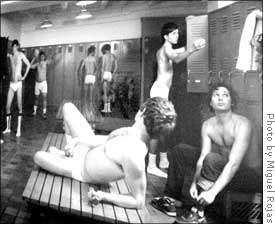
| << Front page | Arts | March 4, 2005 |
Alum’s photo show on display
Fuchs’s art shown in Venturi
 |
||
| A section of "Coetis Thermis: Apodyterium" by OC alum Rebecca Fuchs. You can view this photo among others in the Venturi addition of the Art building. | ||
Rebecca Fuchs, a recent graduate of Oberlin College, displayed her talents in a small photography show that opened last Friday in the art building’s Venturi addition. Her show seemed to have come out of nowhere, but it landed with a bang upon art-hungry viewers. After continuously returning to the show and considering the work’s impact on me, I finally decided to interview Fuchs herself.
The exhibition of photographs entitled “Locke[d] Room” and “Coetis Thermis” draws the viewer’s attention to male homosocial behavior in public spaces. Her photographs of women in public spaces do not deal with the idea of homosocial behavior since females are more freely able to be physical with one another. In all of these public spaces, Fuchs stages imagined narratives based on activities that could have happened in those spaces. In our interview, she explained to me that she was more interested in using already existing spaces so as to make the viewer more aware of possible occurrences there. She shoots all of her work with a 4x5 camera, which holds a larger negative (4 x 5 inches) than a 35 mm camera. Fuchs prefers the 4x5 camera because she is able to better compose the shot before executing it. In planning the shot, she will make a number of sketches and drawings in order to position each person and object exactly as she wants it to be seen.
The blatant homoeroticism in the locker room is a key issue in Fuchs’s photographs of men. The gazes exchanged by some of the men photographed cause viewers to reconsider the activities that occur in these spaces. Her photographs of women in the bathroom and locker room, however, do not display the same homoerotic behavior. The women are not displaying either heterosexual or homosexual behavior; rather, they are relishing their fluidity and ability to be physical with one another.
Unlike many female photographers working in contemporary art, Fuchs claims that she is not interested in making “identity art.” She seems to be more interested in power dynamics amongst men and women and the way that she, as a female photographer, becomes the one holding the gaze upon men. In this way, however, she is able to objectify men and hold power through the gaze, thus reclaiming the gaze for herself as a female photographer. Her main influences, interestingly, are all men: she is drawn to Renaissance sculpture and painting that focus on the ideal Greek male body, the Pieta and Paul Cadmus’s locker room etchings. Her idea of the female in art history arises from paintings of the Virgin Mary, who she sees as the most represented female archetype and a passive iconic reference.
Fuchs’s work is well-staged and executed, exhibiting balanced colors and appropriate lighting. Technically, it is near perfect. She has also put a great deal of thought behind the photographs. The classical references in a contemporary context exhibit her knowledge of both art history and gendered spaces. Problems only arise when taking into consideration that the male bodies in the photographs are not the “ideal Greek bodies” that she claimed to be striving to show. Though the theme of male homoeroticism in public spaces such as the locker room has been examined numerous times, Fuchs is able to overcome the cliché and present a new and thoughtful body of work by drawing on numerous historical references.
The photographs of women, however, are given far less attention than those of men, which causes one to wonder why Fuchs did not investigate the possibility of female homosocial behavior in public spaces. In response, she claimed that this would end up being too pornographic and thus another fetishized object for the male gaze. In the future, however, she tells me that she is interested in finding a way to explore female homosocial behavior without making it pornographic.
Her work is challenging to a wide variety of viewers regardless ofwhether or
not they have any art historical background. With a background in art history,
however, the viewer is able to see the postmodernist method of appropriation in
the beautifully printed work. If nothing else, one leaves with a greater
awareness of social behavior in public spaces. Though Oscar Wilde may say that
“all art is meaningless,” one can argue that one of the key purposes
of art is to raise awareness. Fuchs’s work causes viewers to re-think
their interactions in same-sex social spaces and the implications of the gaze,
among other things.
About us
Subscriptions
Advertising